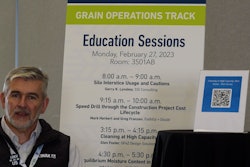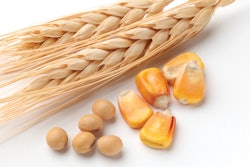.jpg?auto=format%2Ccompress&q=70&w=400)
Before the COVID outbreak stopped all such activities, I was given a tour of a dairy farm’s grain facilities while visiting. Corn was stored on the ground under a roof in small bunkers. This is quite typical for medium-sized farms that work with total mixed ration (TMR), as it enables the loading tractor to scoop up corn easily to unload into the mixer.
There were two great piles of corn, nearly identical from afar, but completely different upon close inspection. To the left, corn was what one would consider typical yellow dent corn No.2. It was perfectly clean, and all grains were identical in shape, color, and size — all within limits of natural variation, of course.
To the right, the heap of corn was a curious mix. It consisted of what one could call pop-corn grains — small spherical grains — and oblong undented grains. Given my agricultural background (there had to be a use for all those courses on Crop Sciences), I could only assume, but not guarantee, that the farmer had kept back seed and that F2 generation gave the typical fracture of genetics, but that is another story.
What really stood out to me was the amount of non-corn material blended along with that sort of corn. It was all field debris from the harvesting process. A rough estimate was that the foreign material exceeded 20% as I could find chunks of corn cobs along with stalk pieces and all other parts of the corn plant.
When I asked the farmer why he bought that lot, he said it was cheaper by 2 cents compared to the other one and, no, he had not noticed the foreign material before nor the curious mix of corn genetics.
To my question whether he had a grain scalper, he answered: “What is a grain scalper?”
What’s a grain scalper?
It's a machine that cleans grains from foreign material; that simple. It works by aspiration, removing the lighter parts, and by sieving to remove smaller items. It can also include a magnet to remove any metal, and the sophistication can increase as its price increases. At one end, you have a stream of clean grain and at the other end a stream of foreign material, which is not to be dumbed, but again that is another story.
Scalpers or cleaners are used also in human-grade grains and legumes. This is why our beans contain no stones and our wheat no chaff from the fields. As a matter of fact, legumes for human consumption undergo a final cleaning stage that involves removing grains that bypassed the scalper but are unfit for human consumption.
The nutrition connection
Going back to my farm visit, I could tell that the clean corn would provide the dairy cows with the full energy/protein value of corn according to book values. Forgetting the genetic split, the other pile of corn with 20% foreign material would provide 80% of the nutritive value of corn and 20% of something else. At best, it would be fiber that would be converted in energy, but the efficiency would certainly be less compared to corn starch.
So, the animals would be provided with less total energy and milk production would suffer. It does not take a PhD degree — only simple algebra — to realize that what is not corn cannot provide the nutrients of corn and the same goes for all grains.
At the feed mill level
Feed mills that do not have a scalper depend on grain elevators to provide them cleaned grains — a risky proposition in my opinion — as not every grain elevator has a grain scalper. And, if you buy grains from a trader, who has no knowledge of the actual product, then there is the risk of receiving uncleaned grains.
Of course, in some countries, there are norms and guarantees that need to be followed in grain trade, but not all countries have them. As it happens, the dairy farm that I visited had bought that dubious corn batch from a nearby country! So, in my opinion a grain scalper is a must if you want to ensure you always use clean grains.
The case for monogastric
As most foreign material in unclean grain is fiber rich, the problem becomes immense in the case of monogastrics, such as poultry and pigs. These species cannot handle much fiber in their feeds and respond by reducing their growth if the feed contains more fiber than they can handle.
I have had the unpleasant experience of tracing a low-feed intake problem in broilers back to grain that never saw the end of a grain scalper, but it was already too late as all corn had to be ground. It was the chemical analysis of the ground corn that gave up the secret as its fiber level was high above any acceptable level.
We ended up reducing the amount of high-fiber corn and enriching the feeds with extra oil. At the end, the cheaper corn proved to be a more expensive exercise than the farmer had thought. I am sure the dairy farmer I visited realized the same!
In summary, a grain scalper is not the kind of machinery widely known to most nutritionists. In fact, we all assume grain is always clean before final delivery to the feed mill, which is a dangerous assumption, especially if nutrient book values are used.
Feed mills that cannot guarantee deliveries of clean grains should either inform the nutritionist to downgrade the quality of such grains as a precaution or buy a grain scalper. At the end, you pay only for the actual corn, so the final price may not be that you see in the invoice, but rather much higher due to excess foreign material.


















